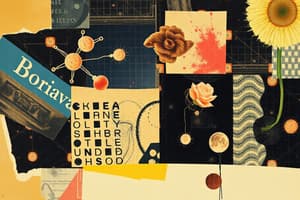Podcast
Questions and Answers
What is the role of antioxidants in protecting cells?
What is the role of antioxidants in protecting cells?
- Promoting the production of free radicals
- Increasing cellular damage
- Preventing damage to cellular components caused by free radicals (correct)
- Activating genes that code for free radicals
How do antioxidants terminate the chain of free radical reactions?
How do antioxidants terminate the chain of free radical reactions?
- By enhancing the production of free radicals
- By promoting the chain reactions
- By shielding cells from antioxidants
- By getting oxidized themselves or removing free radical intermediates (correct)
Which classification of antioxidants is based on their solubility?
Which classification of antioxidants is based on their solubility?
- Natural & synthetic antioxidants
- Water & Fat soluble antioxidants (correct)
- Enzymatic & non-enzymatic antioxidants
- Endogenous & exogenous antioxidants
What is the main function of chelating elements like metals in antioxidant mechanisms?
What is the main function of chelating elements like metals in antioxidant mechanisms?
Which type of antioxidants include Ascorbic acid, Uric acid, and glutathione?
Which type of antioxidants include Ascorbic acid, Uric acid, and glutathione?
How are natural and synthetic antioxidants classified?
How are natural and synthetic antioxidants classified?
What happens when a weak bond breaks in a molecule?
What happens when a weak bond breaks in a molecule?
Which of the following is an example of oxygen-containing free radicals?
Which of the following is an example of oxygen-containing free radicals?
What is the primary oxygen radical formed when an oxygen molecule acquires an electron?
What is the primary oxygen radical formed when an oxygen molecule acquires an electron?
Which macromolecules of the cell can be damaged by highly unstable and reactive free radicals?
Which macromolecules of the cell can be damaged by highly unstable and reactive free radicals?
Under what conditions are oxidants formed as normal products of aerobic metabolism in cells?
Under what conditions are oxidants formed as normal products of aerobic metabolism in cells?
What is the term used to describe an excited state of O2 in which the spin of one unpaired electron is changed?
What is the term used to describe an excited state of O2 in which the spin of one unpaired electron is changed?
What is the tripeptide made up of cysteine, glycine, and glutamine called?
What is the tripeptide made up of cysteine, glycine, and glutamine called?
Which enzyme can utilize glutathione as a substrate to remove free radicals like hydrogen peroxide?
Which enzyme can utilize glutathione as a substrate to remove free radicals like hydrogen peroxide?
What is considered a biomarker of oxidative stress in conditions like hypertension?
What is considered a biomarker of oxidative stress in conditions like hypertension?
Which antioxidant protects the integrity of erythrocyte membrane by scavenging peroxyl radical and hydroxyl radicals?
Which antioxidant protects the integrity of erythrocyte membrane by scavenging peroxyl radical and hydroxyl radicals?
Which fat-soluble antioxidant is considered a chain-breaking antioxidant?
Which fat-soluble antioxidant is considered a chain-breaking antioxidant?
Where are fat-soluble antioxidants normally localized in cells to help protect cell membranes?
Where are fat-soluble antioxidants normally localized in cells to help protect cell membranes?
Flashcards are hidden until you start studying
Study Notes
Antioxidants and Free Radicals
Glutathione (GSH)
- Tripeptide composed of cysteine, glycine, and glutamine
- Present in all human cell types in reduced form (GSH) and oxidized form (GSSG)
- Acts as an antioxidant by donating hydrogen atoms and reducing free radicals directly or as a substrate for enzymes like glutathione peroxidase
Uric Acid
- End product of purine metabolism in humans
- Last two reactions in uric acid formation generate free radicals, making it a biomarker of oxidative stress in conditions like hypertension
- Acts as a free radical scavenger, quenching singlet oxygen and scavenging peroxyl and hydroxyl radicals, protecting erythrocyte membrane integrity
- Major antioxidant in plasma, protecting cells from oxidative damage
Bilirubin
- Chain-breaking antioxidant that becomes oxidized to biliverdin, but can be recycled back to bilirubin by biliverdin reductase
- Protects cells from oxidative damage
Fat-Soluble Antioxidants
- Hydrophobic in nature, localized in cell membranes, and protect against lipid peroxidation
- Examples include vitamins (Vit. A, Vit. E)
Definition and Classification of Antioxidants
- Molecules that prevent damage to cellular components from free radical reactions
- Classified based on properties, source, function, and solubility (water-soluble and fat-soluble)
- Other classification methods include natural and synthetic, enzymatic and non-enzymatic, endogenous and exogenous, and primary and secondary antioxidants
Free Radicals
- Molecules with unpaired electrons, formed when a weak bond breaks
- Examples include superoxide anion radicals, nitric oxide radical, singlet oxygen, and hydrogen peroxide
- Formed as a normal product of aerobic metabolism, but can cause oxidative damage when produced in excess
Studying That Suits You
Use AI to generate personalized quizzes and flashcards to suit your learning preferences.





